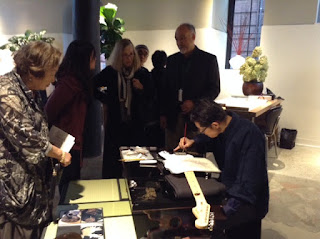" Sanemori" Art by Kumiko Lawrence
While doing research for my DigiLetter (https://us.mag2.com/)on the Japanese epic Heike Monogatari ('Tales of the Heike' 「平家物語」) and the Noh plays it inspired, I've come across many samurai warriors I can relate to: Sanemori 実盛 and his concerns about ageism, Tadanori and his resentment for not receiving acknowledgement for his creative endeavors, the embittered old warrior Yorimasa 頼政 and his resentment of the opaque 'glass ceiling'... I don't think I'm unique in being able to relate to these characters. Their anger and disillusionment at the end of their lives transcends cultural and temporal differences. These are injustices that still occur today and are not uniquely Japanese.
I'm no longer surprised at being able to relate to characters from a very different culture, in a very different line of work, from plays written more than six hundred years ago. It still surprises me, however, when I feel sympathy for a strange and evil demon. This has happened repeatedly over the years. I am not particularly evil, and I don't think that I flatter myself too much when I state categorically that, while I'm not perfect, I am, in fact, less demonic than most.
And yet I am moved by the texts of several Noh plays of the 'Demon' category. The Noh play 'Nue,' 鵺 for example, tells the story of how the samurai warrior Yorimasa, in his younger days, shot down the monster nue (literally 'nightbird,' a kind of Japanese chimera, mixing body parts of a tiger, monkey, raccoon dog and snake). The nue rose in a black cloud and descended upon the Emperor, terrorizing him until being felled by Yorimasa's amazing arrow shot. He was then killed, stuffed in a log and set adrift in a river.
The story illustrates the heroic Yorimasa's amazing marksmanship. The Buddhist shadings of the Noh, however, tell of the sufferings of the nue, and of his shame. The play doesn't condone the nue's actions, but it conveys the monsters suffering sympathetically. It's cries for prayers to relieve its agitated soul's suffering are heart-wrenching.













